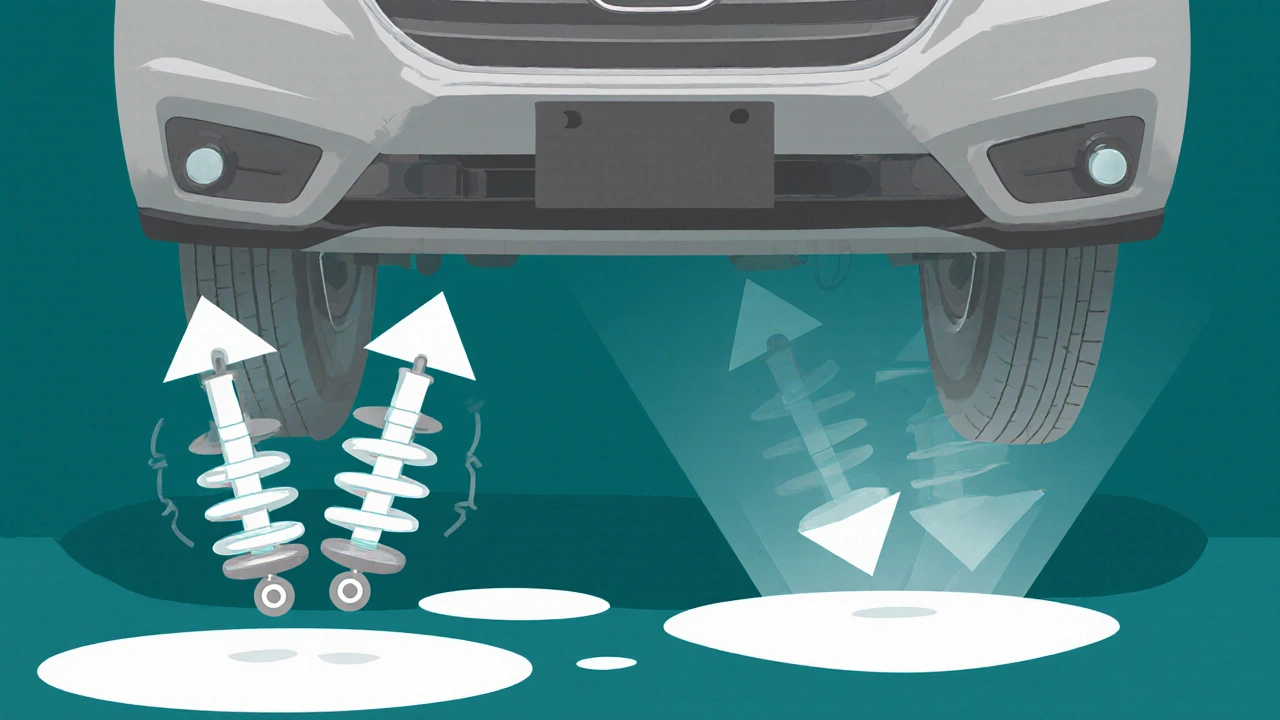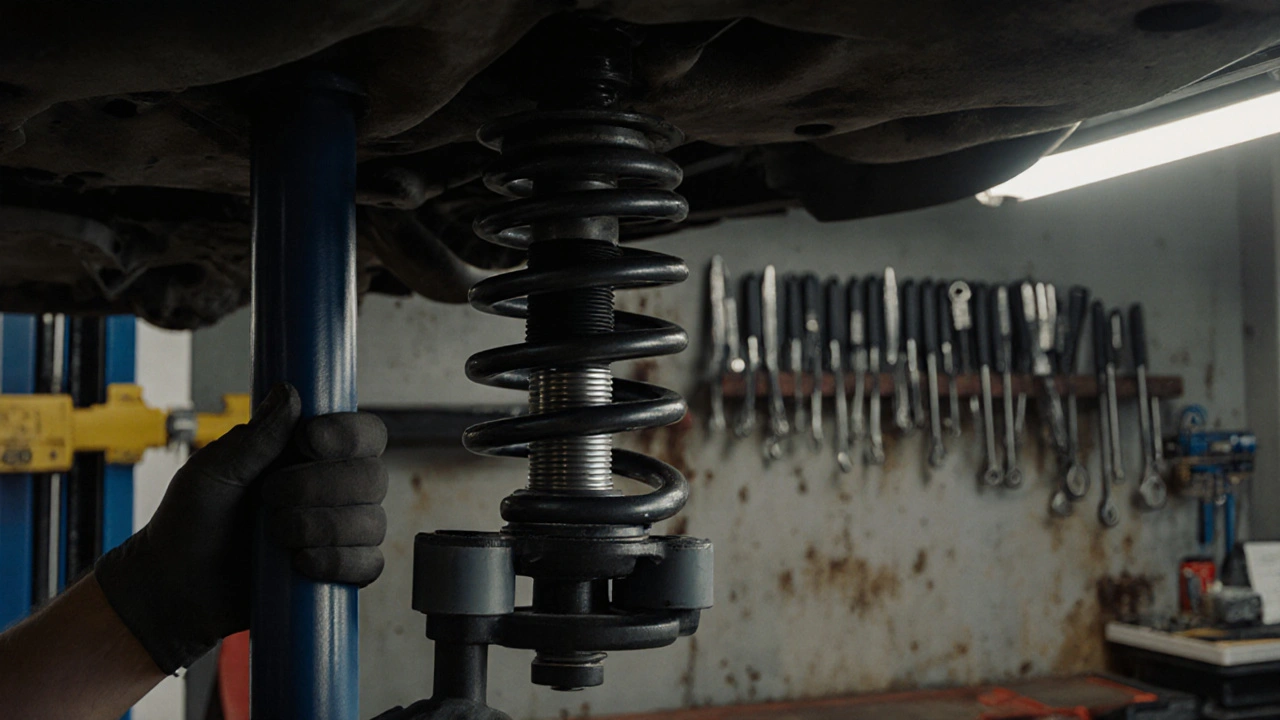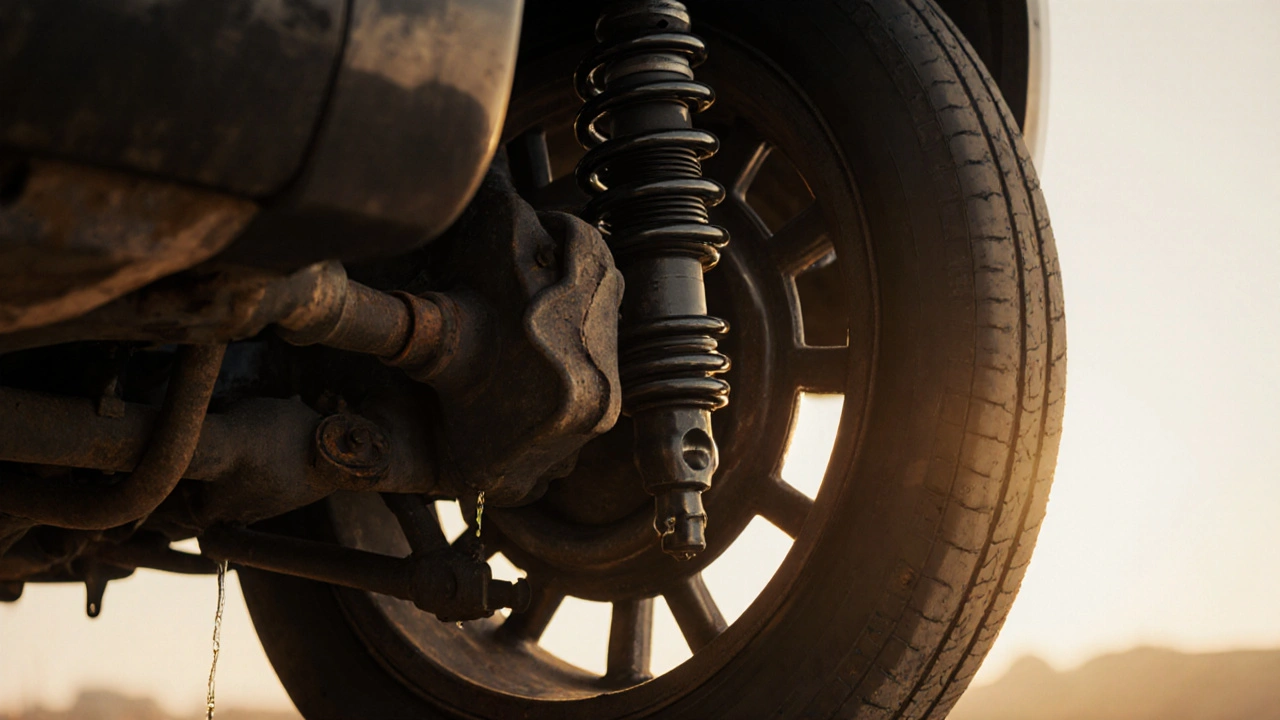Your car doesn’t just roll on wheels-it rides on a system you rarely think about until it starts clunking, bouncing, or pulling to one side. That system is the suspension, and its three core parts-springs, shocks, and struts-work together to keep your tires on the road, your passengers comfortable, and your steering responsive. Skip suspension maintenance, and you’re not just risking a rough ride. You’re risking safety, tire wear, and expensive repairs down the line.
What Each Part Does (And Why It Matters)
Think of your suspension like a team. Each member has a job, and if one fails, the whole system suffers.
Springs support the weight of your car. They’re the coiled steel or torsion bars under each wheel that absorb bumps and keep the chassis level. Without them, your car would bottom out on every pothole. There are two main types: coil springs (most common in modern cars) and leaf springs (used in trucks and older models).
Shocks (or shock absorbers) control the movement of the springs. They don’t carry weight-they slow down how fast the springs bounce back up after hitting a bump. Think of them as speed regulators for your suspension. If your shocks are worn, your car will feel floaty, bounce excessively, and take longer to stop.
Struts are a combo unit. They combine a shock absorber and a spring into one compact assembly, and they also serve as a structural part of the steering and alignment system. Many front-wheel-drive cars and compact SUVs use struts instead of separate shocks and springs. If a strut goes bad, you’re not just losing ride quality-you’re losing steering control and alignment.
How Often Should You Check Your Suspension?
Most manufacturers recommend inspecting suspension components every 50,000 miles. But that’s just a baseline. Real-world conditions matter more.
If you drive on rough roads-think gravel lanes, unpaved driveways, or pothole-ridden city streets-you should check your suspension every 25,000 miles. In the UK, winter roads and salted surfaces accelerate wear. A 2023 study by the RAC found that 38% of cars over five years old showed signs of worn suspension components, mostly due to road conditions, not mileage.
Don’t wait for a warning sign. Get your suspension checked during every oil change if you drive in tough conditions. A quick visual and bounce test can catch problems before they cost you hundreds.
Signs Your Suspension Is Failing
You don’t need a diagnostic tool to know something’s wrong. Your body knows.
- Excessive bouncing: Push down hard on one corner of your car. If it bounces more than once or twice, your shocks or struts are worn.
- Uneven tire wear: If your tires are balding on the inside or outside edges, it’s not a tire issue-it’s a suspension alignment problem caused by worn struts or bushings.
- Steering pull or drift: If your car pulls to one side even after a wheel alignment, the problem could be a bent strut or damaged control arm.
- Noises: Clunking, knocking, or squeaking when going over bumps? That’s metal hitting metal because rubber bushings have cracked or the shock mount is loose.
- Front-end dipping during braking: Your car should stop level. If the nose dives hard, your shocks can’t control the weight transfer.
These aren’t just annoyances. Worn suspension increases stopping distances. The National Highway Traffic Safety Administration found that vehicles with degraded suspension take up to 12% longer to stop on wet roads.
When to Replace: Springs, Shocks, or Struts?
Not all parts need replacing at the same time. Here’s what to look for:
Springs: Rarely fail unless they’re rusted, broken, or sagging. If your car sits lower than it used to-especially on one side-you’ve got a broken or weakened spring. Replacing springs is expensive and usually done with shocks or struts, since you have to take the whole assembly apart anyway.
Shocks: Last 50,000 to 100,000 miles, depending on driving conditions. If they’re leaking oil, feel spongy, or don’t rebound properly, replace them. Don’t mix old and new shocks on the same axle-it creates uneven handling.
Struts: Typically last as long as shocks, but because they’re structural, damage is more dangerous. If the strut housing is bent, the mount is cracked, or the inner seal is leaking, replace the entire unit. Never try to rebuild a strut-there’s no safe way to do it.
Pro tip: Always replace shocks or struts in pairs-front or rear. Replacing just one side throws off your car’s balance and can lead to uneven tire wear and pulling.

How Suspension Wear Affects Other Parts
Bad suspension doesn’t just make your ride rough. It’s a domino effect.
- Tires: Worn shocks cause cupping and feathering. You’ll replace tires 2-3 times faster than normal.
- Brakes: Poor weight control means your brake pads work harder. Brake wear can increase by up to 20%.
- Steering components: Worn struts put extra stress on tie rods and ball joints. These parts can fail suddenly, leading to loss of steering control.
- Alignment: Every time you hit a bump with bad struts, you’re subtly knocking your alignment out of spec. You might need frequent alignments just to keep your car driving straight.
Fixing suspension early saves you money across the board. Replacing a pair of shocks costs £200-£400. Replacing four tires because of uneven wear? That’s £800+.
DIY Check: The Bounce Test
You don’t need a garage to spot trouble. Try this simple test:
- Park on level ground.
- Push down firmly on the front bumper, then let go.
- Watch how the car reacts.
- Repeat at the rear.
If the car bounces more than twice, your shocks or struts are worn. If it bounces once and settles, you’re good. If it keeps rocking like a boat, replace them now.
Also, look under the car. Check for oil leaks around the shock body. A little dampness? Maybe just dust. A wet, oily coating? That’s a failed seal. Don’t ignore it.
What to Look for When Buying New Parts
Not all shocks and struts are created equal. You’ve got three main options:
- OE Replacement: Matches what came with your car. Reliable, affordable, and the safest bet if you just want to restore factory performance.
- Performance: Stiffer, better control, often adjustable. Good if you drive on twisty roads or tow regularly. But they ride harsher on rough surfaces.
- Heavy-duty: Built for off-road or commercial use. Thicker shocks, reinforced mounts. Overkill for daily driving, but great if you haul heavy loads.
Brands like Monroe, KYB, and Bilstein are widely trusted. Avoid no-name brands from unknown sellers. Suspension parts are safety-critical. Cheap parts can fail without warning.
Always match the part number to your VIN. A 2020 Ford Focus doesn’t use the same strut as a 2020 Honda Civic-even if they look similar.

Professional Installation: Is It Worth It?
Replacing shocks is doable for a DIYer with basic tools. Replacing struts? That’s a job for a pro.
Struts are under spring tension. Removing them requires a spring compressor-a tool most home mechanics don’t own. Improper removal can send a spring flying. I’ve seen videos where people get injured trying this alone.
Plus, after replacing struts, you need a wheel alignment. Most garages include this in the price. If you do it yourself, you’ll still need to pay for alignment separately.
Expect to pay £150-£300 per axle for labor and parts on a typical family car. It’s not cheap, but it’s cheaper than an accident.
How to Extend Suspension Life
Good habits keep your suspension running longer:
- Avoid potholes and curbs. Even a single hard hit can bend a strut.
- Keep tires properly inflated. Under-inflated tires force the suspension to work harder.
- Don’t overload your car. Excess weight stresses springs and shocks.
- Wash undercarriage in winter. Salt eats away at suspension components faster than you think.
- Get alignments every 10,000 miles or after hitting a major bump.
Simple steps like these can add 20,000-30,000 miles to your suspension’s life.
What Happens If You Ignore It?
Ignoring worn suspension isn’t just about comfort. It’s a safety issue.
On wet roads, your tires lose contact with the pavement more easily. Hydroplaning becomes more likely. Emergency swerves feel sluggish. Your car doesn’t respond the way it should.
Insurance claims from accidents linked to poor suspension are rising. In 2024, the UK’s Motor Insurance Research Bureau reported a 17% increase in claims involving loss of control due to suspension failure.
And here’s the kicker: most insurance policies won’t cover damage caused by neglect. If you’re in an accident and it’s found your shocks were worn beyond recommended limits, you could be on the hook for repairs.
How long do suspension springs last?
Springs can last the life of the car if they’re not damaged or rusted. But in areas with salted roads or rough terrain, they can weaken after 100,000 miles. Look for sagging, uneven ride height, or visible cracks.
Can I drive with a broken strut?
No. A broken strut compromises steering, braking, and stability. You risk losing control, especially in emergency maneuvers. Get it towed to a shop immediately.
Do I need to replace shocks and struts at the same time?
You should replace them in pairs-front or rear-to keep handling balanced. Replacing only one side can cause uneven wear, pulling, and poor braking performance.
How do I know if my car has shocks or struts?
Look under the car. If there’s a large, cylindrical unit connected directly to the wheel hub and the body, it’s a strut. If there’s a separate spring and a thinner, cylindrical shock absorber next to it, you have shocks. Most modern front-wheel-drive cars use struts; older or rear-wheel-drive cars often use shocks.
Is it cheaper to replace shocks or struts?
Shocks are usually cheaper to replace because they’re simpler and don’t require alignment afterward. Struts cost more because they’re more complex and require a wheel alignment after installation. Parts alone can be £50-£150 per unit, but labor for struts adds £100-£200 per axle.
Next Steps: What to Do Today
If you’re unsure about your suspension, start with the bounce test. If it fails, book a professional inspection. Don’t wait for a noise or a warning light-by then, it’s too late.
Keep a record of your suspension checks. Note the date, mileage, and what was found. It helps you track wear patterns and gives you proof of maintenance if you ever sell the car.
Suspension isn’t glamorous. But it’s one of the most important systems you’ll never notice-until it fails. Take care of it, and your car will reward you with a smooth ride, better control, and years of safe driving.


Comments
Anand Pandit
Great breakdown! I’ve been doing the bounce test every oil change since my last alignment went south. Caught a worn strut early-saved me a fortune in tire replacements. Seriously, this stuff matters more than people think.
November 12, 2025 at 17:19
Reshma Jose
Same here. My 2018 Swift was bouncing like a pogo stick after monsoon season. Took it in, turns out both front struts were leaking. Replaced them with KYBs and now it rides like new. Also, wash the undercarriage after every rain-salt is a silent killer.
November 14, 2025 at 08:50
rahul shrimali
Do the bounce test dont wait for noise
November 15, 2025 at 14:01
Eka Prabha
Let me guess-this was sponsored by Monroe or Bilstein. The NHTSA and RAC stats are cherry-picked to sell parts. Realistically, most suspension failures are engineered obsolescence. Car manufacturers design parts to fail at 80k miles so you keep coming back. And don’t get me started on alignment being a cash grab. You think your car needs an alignment every 10k miles? That’s not engineering-that’s profit motive.
My 2010 Civic has 190k on original struts. Still rides fine. No leaks. No noise. No alignment issues. The only thing that failed was the dealership’s patience when I refused to replace them.
Don’t fall for the fear-mongering. Suspension isn’t a ticking bomb. It’s a system that lasts if you don’t abuse it. And if you drive on potholes? That’s your fault, not the car’s.
November 16, 2025 at 00:52
Bharat Patel
It’s funny how we ignore the things that keep us safe until they stop working. We obsess over horsepower and infotainment screens but treat suspension like an afterthought. Maybe we’ve forgotten that the car’s job isn’t to impress-it’s to carry us, quietly and reliably, from one place to another.
That bounce test? It’s not just a diagnostic tool. It’s a moment of connection-with your machine, with your safety, with the road you drive on every day. Most people don’t feel that. They just hear the clunk and blame the road.
November 17, 2025 at 09:58
Bhagyashri Zokarkar
i had this one time my car was like wobbling so bad i thought it was gonna flip and then i found out it was the shocks and like i was so scared i just stopped driving for like 2 weeks and then i took it to this sketchy garage where they said i needed new struts and it cost me like 8k rupees and honestly i think they ripped me off but now my car feels like a boat and i dont even trust it anymore and i just drive super slow now and i hate everything
November 19, 2025 at 06:10
Rakesh Dorwal
Why are all these recommendations based on Western standards? In India, we drive on roads that would make a BMW cry. You think a £400 shock is gonna last here? That’s a joke. We need heavy-duty suspension built for Indian roads, not some European luxury parts. And why no mention of local brands like JCB or Tata AutoComp? They make decent parts that actually survive our potholes.
Stop importing foreign advice. We know our roads better than the RAC ever will.
November 21, 2025 at 00:32
Vishal Gaur
So i read this whole thing and i think its kinda right but like i replaced my shocks last year and now my car feels way too stiff like its gonna break my spine every time i hit a bump and i dont think performance shocks are worth it for city driving unless you like your spine vibrating every day and also i think the alignment thing is overblown i only did mine once and its been fine for 3 years so maybe just drive nice and dont hit curbs and youll be ok
November 21, 2025 at 12:36
Nikhil Gavhane
This is the kind of post that reminds me why I still believe in thoughtful, practical advice online. Too many people treat cars like disposable gadgets. But a car is a tool that keeps us moving-literally and emotionally. Taking care of the suspension isn’t about spending money. It’s about respecting the machine that gets you home safely every day.
Thanks for writing this. I’m going to do the bounce test this weekend.
November 22, 2025 at 01:19
Rajat Patil
It is important to recognize that the suspension system functions as a critical link between the vehicle and the road surface. Any degradation in its components may result in a reduction of overall vehicle stability. I recommend that all vehicle owners conduct periodic inspections in accordance with manufacturer guidelines, particularly in regions with adverse road conditions. Proactive maintenance is a responsible practice that enhances safety and longevity.
November 23, 2025 at 20:32
deepak srinivasa
If struts are structural and shocks aren’t, why do some cars have shocks in the front and struts in the back? Doesn’t that mean the rear is less critical for steering? Or is it just a packaging thing? I’m trying to understand the logic behind the design choices.
November 24, 2025 at 21:12
pk Pk
Everyone here is overcomplicating this. Do the bounce test. If it bounces more than twice, get it checked. Don’t wait. Don’t argue. Don’t wait for a noise. Don’t wait for a warning light. Just do it. Your tires, your brakes, your kids in the backseat-they’ll thank you later.
And if you’re not sure what to buy? Go with Monroe. They’re everywhere for a reason. Not flashy. Not expensive. Just works.
November 25, 2025 at 13:16
NIKHIL TRIPATHI
Just had my rear struts replaced last month. Wasn’t even aware they were bad until I hit a speed bump and the whole back end just… floated. Like a boat. Weird feeling. The shop said it was a classic case of salt corrosion from last winter. Also, they threw in a free alignment. That’s the kind of service that makes you trust them. And yeah, replacing in pairs? Non-negotiable. One side new, one side old? Bad idea. Car pulls. Feels weird. Just don’t.
November 25, 2025 at 14:11
Reshma Jose
That’s exactly what happened to me. I thought the rear was fine because there was no noise. But the car felt loose in turns. Turns out the rear struts were shot. Replaced both sides and now it’s like a different car. Don’t ignore the rear. Everyone forgets about it.
November 25, 2025 at 21:27